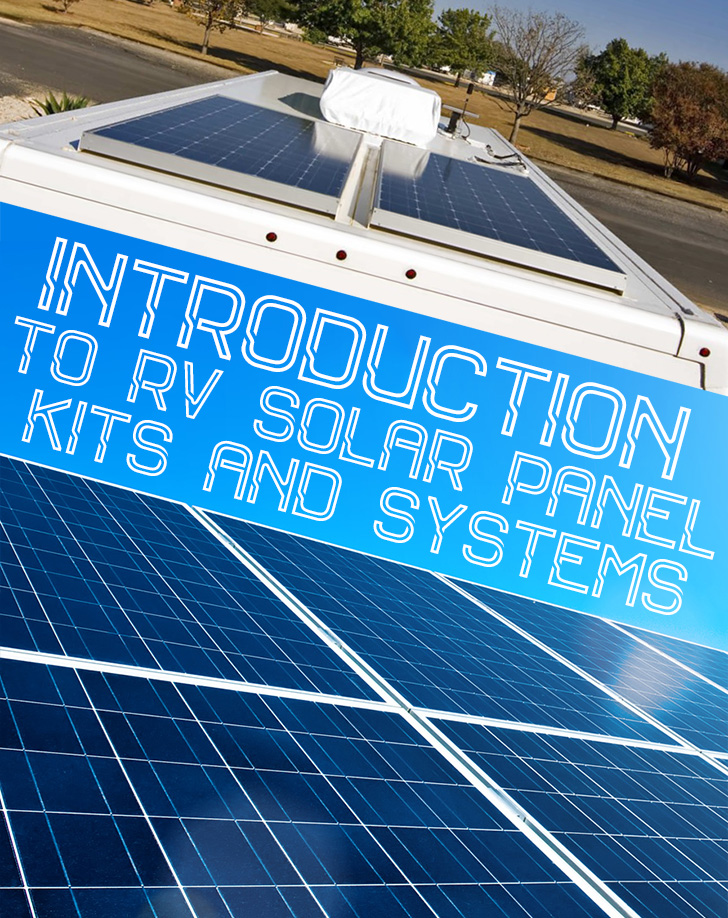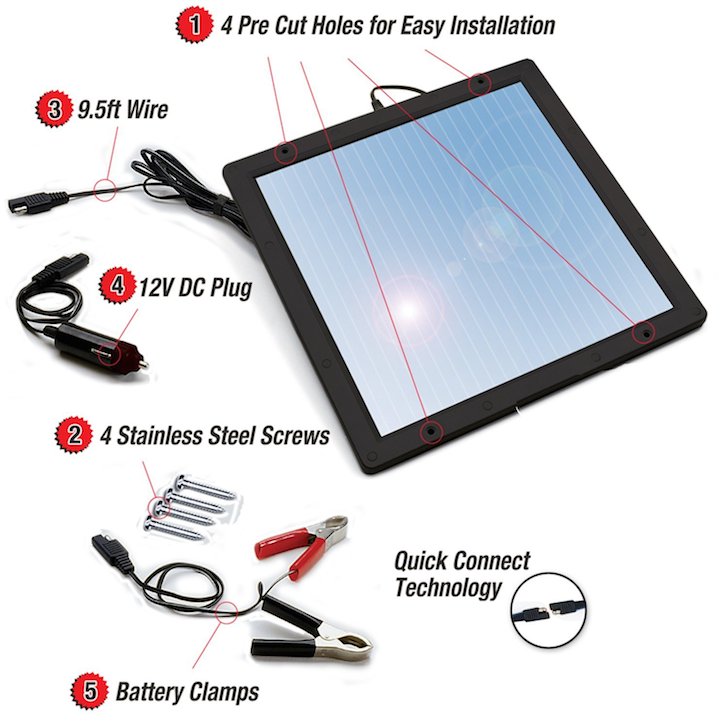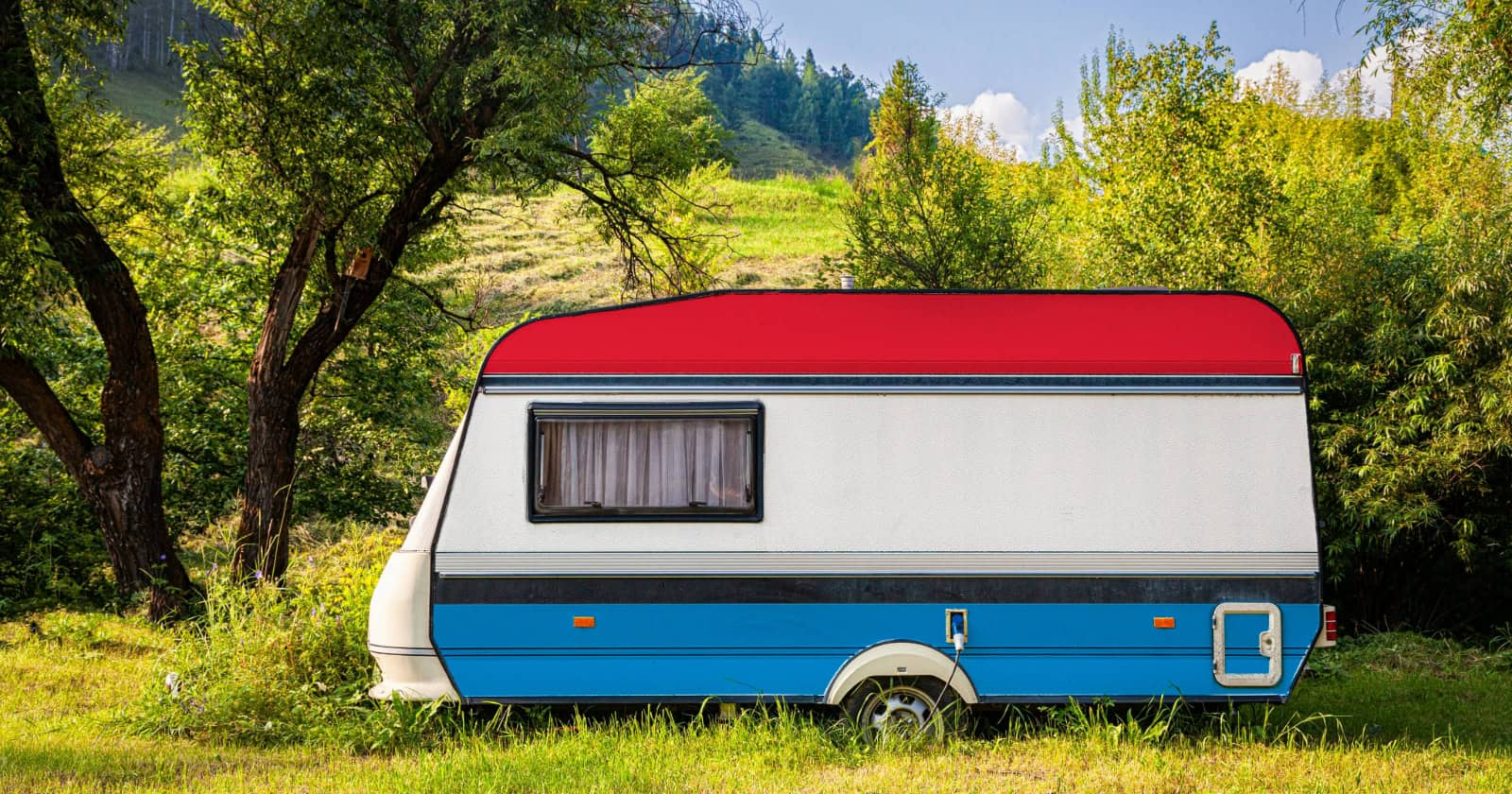More and more RVers are considering adding solar power to their rigs.
Maybe it’s the result of a cultural shift toward green energy or simply the convenience of having enough power to camp outside of comfortable but confining RV parks.
Whatever the reason, it’s clear that RV solar power systems are here to stay.
In this article, we’ll introduce you to the basic parts of an RV solar system, and talk a little about why you might consider adding such a unit to your rig.
RV Solar Power Basics
RVers install solar panels for two main reasons:
- to trickle charge house batteries
- as a source of primary electrical power
Solar Power Trickle Charging
When your RV sits for a prolonged period of time, your house batteries begin to lose power – regardless if they’re used or not.
For car owners this is the reason a battery dies after the car sits idle for too long.
The same principle applies to your RV. It’s also important not to leave the batteries dead for long periods of time as this could cause permanent battery damage – and leave them unable to hold a charge ever again.
All that’s needed to avoid much of the pain associated with a dead battery is a solar trickle charger. This charger will also keep your batteries fully charged and ready to go when the time comes to use them.
A solar trickle charger is usually a stand alone device that creates several watts of power for charging and maintaining RV house batteries.
These chargers are usually made of durable plastic and amorphous solar cells (more on that below), and are molded into a weatherproof unit that’s about a foot and a half square.
Installation is simple and straightforward.
Just take the small panel, usually no larger than a dinner plate, and connect the wires and battery clips.
Place the panel in the sun and voilà!
There is a chance that if you have a late-model RV you’ll already have one of these units installed directly by the manufacturer.
Here’s an example of what a solar trickle charger looks like:
Using Solar Panels For Primary Electrical Power
The second use of solar panels is to provide primary power to RV house systems.
This involves the installation of several solar panels and other gear, together sometimes called a solar kit, to create and regulate enough power for routine operation of your RV’s house systems.
For anyone new to RV solar, it’s easiest to think of an RV solar system as more or less a big, expensive battery charger.
Anything that can run off your batteries can be run from an RV solar system.
As you can imagine, RV solar systems are especially helpful for boondockers and dry campers.
An RV solar panel is much like a battery in that it supplies electricity at a certain voltage.
The major difference is that the panel itself needs the sunlight to make electricity while batteries require a chemical reaction to do the same.






I don’t see a answer for your post Brain, would like to know what you found out please, thank you
OH, and don’t forget start-up current on the compresser is several times running current. The Yetis are rated at 1500W peak.
You might get an hour or two of air conditioning from the Yeti 1250. I have a Goal Zero Yeti 150 that will run a C-PAP for (almost) an hour. Maybe longer if I slept during daylight hours. 😉
I have a 2015 40′ Forrest River Villa park home model. All the lights are 12 v, and the water pump. Being a park home model it has a home type frig, microwave, the propane furnace, But I would guess a 110v blower. I want a system that if the grid goes down for an extended time I can power about 90% of most of my appliances being conservative with use. The hot water is propane, but has an electrical element also. I who knows next to nothing about a proper system to match up with the RV’s electrical system. How many batteries will I need in my bank. Since the RV has inverter and converter, is a charging controller the only of hardware I will need? Also how many sq. ft. of panels will I need. Only get good direct sunlight from noon on, so in the winter I loose several hours of sun. So would I need a couple more panels that I can engage for the seasonal change. I am sorry about being lengthy, I don’t want some fly by night selling me junk. I am on a pension so I need to by a system to start, and that can be expanded over time.
Yeah, kind of like the model airplane hobby or these new drones, you could make them yourself with a la carte parts, or just buy the $150 drone from Amazon (even if you don’t know what you’re doing!)
LOL Brian, yeah that statement didn’t make sense, we’ve got it fixed, thanks for the catch. Sounds good with the 85W panel, look forward to hearing the results of your testing.
I think in large part is’t due to just what you are getting with your panel. Being an EE, I am comfortable buying raw panels, separate controllers and doing all the wiring and figuring stuff out myself. Other folks aren’t as comfortable working with electricity and would make better use of the complete kits that are just plug & chug. Those kits are going to cost more $$ per watt because someone has done the engineering work already.
For some of us twisted folk, that kind of stuff is actually fun.
In the section “How Much Solar Power Do You Need For Your RV?” you talk about a panel that can deliver 10A as being about a 100W panel. Fair enough. Then you say “If you go higher, like with this 15 watt solar charging kit, . . .”
Is this a result of too much common core math? When is a 15W system (and that’s what the link shows) bigger than the 100W panel you were talking about? Oh and that 15W system? at $120 it’s kind of over priced
For the record, I have an 85W panel I am planning to use with my hybrid camper. For boondocking, using some interior lights, maybe a stereo some days and the water pump, it will do. I’ll have to report back and let you know how it goes . . .
Thanks for your comment PH. Sounds like you will have a serious off-grid bus when you’re through!
Converting a MCI 9 bus and will have multiple power sources. Propane powered generator, solar system and a wind generator in the future. Start with a solar system that you can add to as time and $ allow and have back up.
Why is there such a large discrepancy in solar Panay prices is there a difference or is this just a supply and demand
I am new at solar and camping. Can I hook up the batterie to solar panel and at the same time use this charging batterie?
Hi Michelle,
That sounds like an interesting idea. We’ll look into it further for you. Thanks for your comments and ideas.
Has anyone tried attaching a wind generator (ex. marine grade) to your trailer?
Over the winter we are going to remodel our 1988 Road Runner fifth wheel in which we mainly use for 2-3 days at a time at drag races and no hookups. We are installing solars on both it and our enclosed trailer we haul our dragster. I was wondering if anyone has tried the wind turbines to supplement power? We build solar/wind units for use in remote location in the oilfields and the combo works great, but since we are new to working and traveling in travel trailers, not sure how practical it would be.
Thanks for your help.
I want to put as high of capacity solar in roof of a step van as I can fit, I can fit 4 250 watt panels with some left over room . what is the best way to get max power. I was thinking of higher voltage panels then charge controller to charge 12v battery bank, will have 4 deep cycle batteries maybe more, and 3000 watt inverter to run freezer equipment. what are your thought on 24v , 48v , panels how many amps can they produce? you can call me at (702) 354-8487 Harrel.
I have a 100 watt solar system on my trailer utilizing two AGM 6 volt batteries. These batteries require a low charge rate. When towing, am I charging at too high a rate from the trucks alternator?
Battery University says:
AGM batteries are sensitive to overcharging. The float charge should be reduced to between 2.25 and 2.30V/cell (summer temperatures may require lower voltages). Automotive charging systems often have a fixed float voltage setting of 14.40V (2.40V/cell). To a sealed unit, this could spell trouble by exposing the battery to undue overcharge on a long drive.
I’m considering not charging while towing. The solar panels will suffice. If I drain them too low and require immediate assistance, I’ll use shore power or generator through my portable battery charger that is adjustable. On shore power, I’ll just set it on trickle.
THOUGHTS?
Thanks Timothy! We really appreciate you saying so. Come back and visit anytime!
INFO WAS GREAT
That is one way to announce a typo, thanks!
“Place the panel in the sun and viola! ” Is that like violin?
Yep, the Yeti! While searching for a small, quiet inverter generator this week, I stumbled across it. Of course, would need two for a 13,500 BTU AC on the RV to run, and that’s a bit pricey…
No! But now after a google search I have. Is this the one your talking about?
Thanks for the great overview! Have you seen the solar-powered generator that Lowe’s sells?